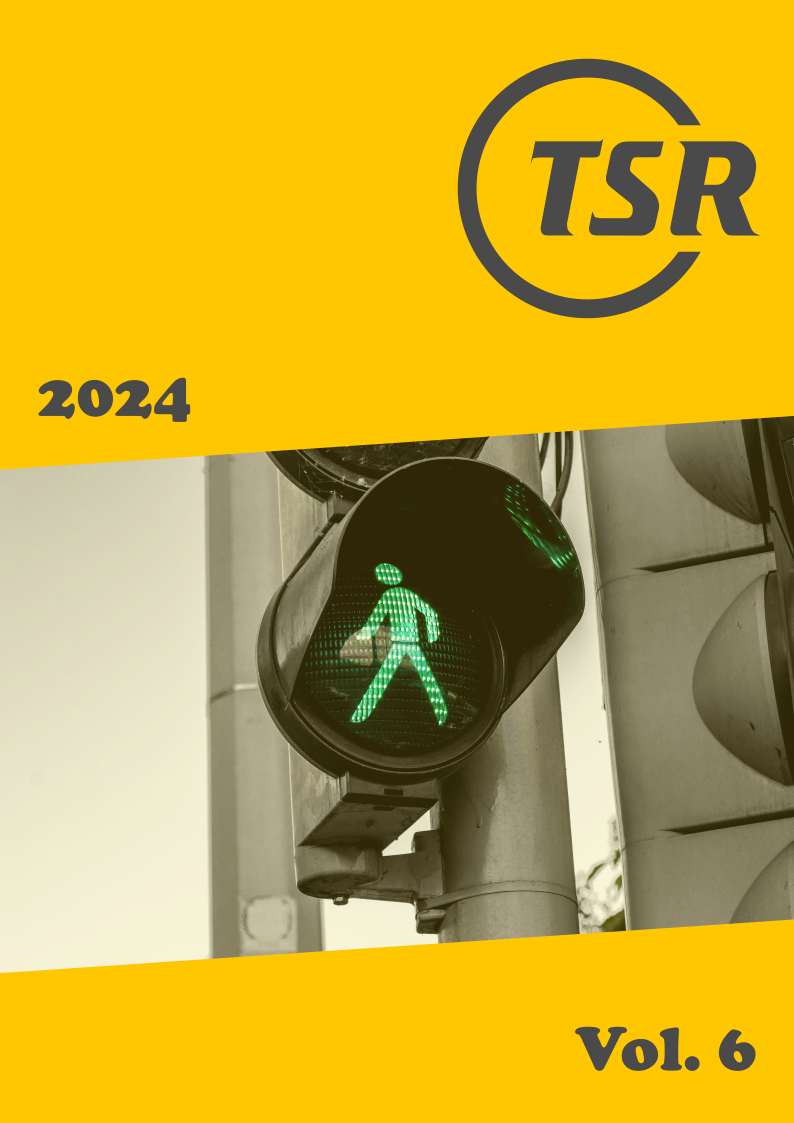A method to assess the safety implications of authority transitions in automated driving
DOI:
https://doi.org/10.55329/fkix6369Keywords:
authority transitions, Cooperative Adaptive Cruise Control, driver behavior, safety, simulationAbstract
Automated Driving Systems (ADS) are aimed to improve traffic efficiency and safety, however these systems are not yet capable of handling all driving tasks in all types of road conditions. The role of a human driver remains crucial in taking over control, if an ADS fails or reaches its operational limits. Takeover performance of human drivers in authority transitions is typically assessed by means of the takeover time (TOT) taken within an available time budget (TB). This approach assumes a uniform perception and reaction time of human drivers in ADS disengagements, and does not include the time needed to execute the actual driving maneuver required to ensure safety. This paper aims to develop and test a set of new indicators to reflect takeover performance and its safety attributes, namely the ‘time to control’ (TC) and the ‘safe time budget’ (STB), in which the actual task execution (i.e. braking) time is taken into account, in addition to the perception and reaction time. It also proposes new thresholds for identifying critical conflicts in takeover situations and assessing the safety of authority transitions. A traffic simulation experimental setup is used with mixed traffic of conventional vehicles and ACC/CACC platoons in order to test these indicators and thresholds. The results suggest that the time difference between TC and STB is a more sensitive and potentially more realistic safety indicator, as it may capture the variability of driver behavior in takeovers and identify critical conflicts, as well as virtual crashes, that would not have been identified by the previously used indicators (TOT and TB). Takeover performance worsens when the speed difference of the vehicles involved is higher, and the initial speed of the rear vehicle is higher. These findings can be useful towards a more dynamic design of takeover request strategies.
Downloads
References
Arvin, R., A. J. Khattak, M. Kamrani, J. Rio-Torres (2020), 'Safety evaluation of connected and automated vehicles in mixed traffic with conventional vehicles at intersections', Journal of Intelligent Transportation Systems, 25, 170–187. DOI: https://doi.org/10.1080/15472450.2020.1834392
Baldwin, C. L., B. A. Lewis (2014), 'Perceived urgency mapping across modalities within a driving context', Applied ergonomics, 45(5), 1270–1277. DOI: https://doi.org/10.1016/j.apergo.2013.05.002
Borojeni, S. S., L. Chuang, W. Heuten, S. Boll (2016), 'Assisting Drivers with Ambient Take Over Requests in Highly Automated Driving', 8th International Conference on Automotive User Interfaces and Interactive Vehicular Applications, Michigan, USA., 24 - 26 October 2016, pp. 237-244. DOI: https://doi.org/10.1145/3003715.3005409
Cacciabue, P. C., O. Carsten (2010), 'A simple model of driver behaviour to sustain design and safety assessment of automated systems in automotive environments', Applied ergonomics, 41(2), 187–197. DOI: https://doi.org/10.1016/j.apergo.2009.03.008
Calvert, S.C., B. van Arem (2020), 'A generic multi-level framework for microscopic traffic simulation with automated vehicles in mixed traffic', Transportation Research Part C: Emerging Technologies, 110, 291–311. DOI: https://doi.org/10.1016/j.trc.2019.11.019
Calvert, S. C., W. J. Schakel, J. W. C. V. Lint (2020), 'A generic multi-scale framework for microscopic traffic simulation part II - Anticipation Reliance as compensation mechanism for potential task overload', Transportation Reserach Part B: Methodological. DOI: https://doi.org/10.1016/j.trb.2020.07.011
Dahl, I. A., P. Berlin, C. Fléchon, P. Sukennik, C. Walther (2018), 'Microscopic simulation and impact assessment of the coexistence of automated and conventional vehicles in european cities', Dublin, Ireland, 10–12 October 2018.
Eriksson, A., N. A. Stanton (2017), 'Takeover Time in Highly Automated Vehicles: Noncritical Transitions to and from Manual Control', Human Factors:The Journal of the Human Factors and Ergonomics Society, 59(4), 689–705. DOI: https://doi.org/10.1177/0018720816685832
Flemisch, F., E. Altendorf, Y. Canpolat, G. Weßel, M. Baltzer, D. Lopez, N. D. Herzberger, G. M. I. Voß, M. Schwalm, P. Schutte (2017), 'Uncanny and Unsafe Valley of Assistance and Automation: First Sketch and Application to Vehicle Automation', in Schlick, C. M., S. Duckwitz, F. Flemisch, M. Frenz, S. Kuz, A. Mertens, S. Mütze-Niewöhner (eds.), Advances in Ergonomic Design of Systems, Products and Processes, Springer, Cham. DOI: https://doi.org/10.1007/978-3-662-53305-5_23
Gettman, D., L. Head (2003), 'Surrogate Safety Measures from Traffic Simulation Models', Transportation Research Record: Journal of the Transportation Research Board, 1840(1), 104–115. DOI: https://doi.org/10.3141/1840-12
Gold, C., K. Bengler (2021), 'Taking over control from highly automated vehicles', 12th International Conference on Applied Human Factors and Ergonomics, online, 25–29 July 2021. DOI: https://doi.org/10.54941/ahfe100669
Gold, C., D. Damböck, L. Lorenz, K. Bengler (2013), '‘‘Take over!” How long does it take to get the driver back into the loop?', Proceedings of the Human Factors and Ergonomics Society Annual Meeting, 57(1). DOI: https://doi.org/10.1177/1541931213571433
Hogema, J. H., W. H. Janssen (1996), 'Effect of Intelligent Cruise Control on driving behavior: a simulator study', TNO Human Factors Rsearch Institute, TM-96-C012.
Klunder, G., M. Li, M. Minderhoud (2009), 'Traffic Flow Impacts of Adaptive Cruise Control Deactivation and (Re)activation with Cooperative Driver Behavior', Transportation Research Record: Journal of the Transportation Research Board, 2129(1), 145–151. DOI: https://doi.org/10.3141/2129-17
Koo, J., J. Kwac, W. Ju, M. Steinert, L. Leifer, C. Nass (2015), 'Why did my car just do that? Explaining semi-autonomous driving actions to improve driver understanding, trust, and performance', International Journal on Interactive Design and Manufacturing (IJIDeM), 9, 269–275. DOI: https://doi.org/10.1007/s12008-014-0227-2
Kyriakidis, M., J. C. Winter, N. Stanton, T. Bellet, B. V. Arem, K. Brookhuis, M. H. Martens, K. Bengler, J. Andersson, N. Merat (2017), 'A human factors perspective on automated driving', Theoretical Issues in Ergonomics Science, 20(3), 223–249. DOI: https://doi.org/10.1080/1463922X.2017.1293187
Lint, J. W. C. V., S. C. Calvert (2018), 'A generic multi-level framework for microscopic traffic simulation-Theory and an example case in modelling driver distraction', Transportation Research Part B: Methodological, 117, 63–86. DOI: https://doi.org/10.1016/j.trb.2018.08.009
Liu, H., X. D. Kan, S. E. Shladover, L. X.-Y., R. E. Ferlis (2018), 'Modeling impacts of cooperative adaptive cruise control on mixed traffic flow in multi-lane freeway facilities', Transportation Research Part C: Emerging Technologies, 95, 261–279. DOI: https://doi.org/10.1016/j.trc.2018.07.027
Lu, Z., R. Happee, C. D. D. Cabrall, M. Kyriakidis, J. C. F. Winter (2016), 'Human factors of transitions in automated driving: A general framework and literature survey', Transportation Research Part F: Traffic Psychology and Behaviour, 43, 183–198. DOI: https://doi.org/10.1016/j.trf.2016.10.007
Lu, Z., J. C. F. Winter (2015), 'A Review and Framework of Control Authority Transitions in Automated Driving', Procedia Manufacturing, 3, 2510–2517. DOI: https://doi.org/10.1016/j.promfg.2015.07.513
Merat, N., A. Jamson, F. Lai, O. Carsten (2012), 'Highly automated driving,secondary task performance, and driver state', Human Factors: The Journal of the Human Factors and Ergonomics Society, 54(5), 762–771. DOI: https://doi.org/10.1177/0018720812442087
Milanes, V., S. E. Shladover (2014), 'Modeling cooperative and autonomous adaptive cruise control dynamic responses using experimental data', Transportation Research Part C: Emerging Technologies, 48, 285–300. DOI: https://doi.org/10.1016/j.trc.2014.09.001
Naujoks, F., C. Mai, A. Neukum (2021), 'The effect of urgency of Take Over requestsduring highly automated driving under distraction conditions', in Stanton, N., S. Landry, S. Landry, Giuseppe Di Bucchianico, Andrea Vallicelli (eds.), Advances in Human Aspects of Transportation: Part I. AHFE (2021) International Conference.AHFE Open Access, vol 15, 15. DOI: https://doi.org/10.54941/ahfe100646
Papadimitriou, E., H. Farah, G. V. D. Kaa, F. S. D. Sio, M. Hagenzieker, P. H. A. J. M. V. Gelder (2022), 'Towards common ethical and safe ‘behaviour’ standards for automated vehicles', Accident Analysis & Prevention, 174. DOI: https://doi.org/10.1016/j.aap.2022.106724
Papadimitriou, E., C. Schneider, A. Tello, J. Damen, M. L. Vrouenraets, A. ten Broeke (2020), 'Transport safety and human factors in the era of automation: What can transport modes learn from each other?', Accident Analysis & Prevention, 144, 105656. DOI: https://doi.org/10.1016/j.aap.2020.105656
Papadoulis, A., M. Quddus, M. Imprialou (2019), 'Evaluating the safety impact of connected and autonomous vehicles on motorways', Accident Analysis and Prevention, 124, 12–22. DOI: https://doi.org/10.1016/j.aap.2018.12.019
Petermann-Stock, I., L. Hackenberg, T. Muhr, C. Mergl (2013), 'Wie lange braucht der Fahrer? Eine Analyse zu Ubernahmezeiten aus verschiedenen Nebentatigkeiten wahrend einer hochautomatisierten Staufahrt', Munich, Germany, 28–29 November 2013.
Petermeijer, S. M., J. C. F. D. Winter, K. Bengler (2016), 'Vibrotactile displays: A survey with a view on highly automated driving', IEEE Transactions on Intelligent Transportation Systems, 17(4), 897–907. DOI: https://doi.org/10.1109/TITS.2015.2494873
Politis, I., P. Langdon, D. Adebayo, M. Bradley, P. J. Clarkson, L. Skrypchuk, N. Stanton (2018), 'An evaluation of inclusive dialogue-based interfaces for the takeover of control in autonomous cars', 23rd international conference on intelligent user interfaces, Tokyo, Japan, 7–11 March 2018. DOI: https://doi.org/10.1145/3172944.3172990
Rahman, M. S., M. Abdel-Aty (2018), 'Longitudinal safety evaluation of connected vehicles’platooning on expressways', Accident Analysis & Prevention, 117, 381–391. DOI: https://doi.org/10.1016/j.aap.2017.12.012
Ruscio, D., M. Ciceri, F. Biassoni (2015), 'How does a collision warning system shape driver’s brake response time? The influence of expectancy and automation complacency on real-life emergency braking', Accident Analysis & Prevention, 77, 72–81. DOI: https://doi.org/10.1016/j.aap.2015.01.018
SAE, (2018), 'Taxonomy and Definitions for Terms Related to Driving Automation Systems for On-Road Motor Vehicles', SAE International, J3016_201806.
Schakel, W. J., V. L. Knoop, B. V. Arem (2012), 'Integrated lane change model with relaxation and synchronization', Transportation Research Record: Journal of the Transportation Research Board, 2316(1), 47–57. DOI: https://doi.org/10.3141/2316-06
Shladover, S. E., C. Nowakowski, L. X.-Y, R. Ferlis (2015), 'Cooperative Adaptive Cruise Control: Definitions and Operating Concepts', Transportation Research Record: Journal of the Transportation Research Board, 2489(1), 145–152. DOI: https://doi.org/10.3141/2489-17
Sinha, A., S. Chand, K. P. Wijayaratna, N. Virdi, V. Dixit (2020), 'Comprehensive safety assessment in mixed fleets with connected and automated vehicles: A crash severity and rate evaluation of conventional vehicles', Accident Analysis & Prevention, 142. DOI: https://doi.org/10.1016/j.aap.2020.105567
Treiber, M., A. Hennecke, D. Helbing (2000), 'Congested traffic states in empirical observations and microscopic simulations', Physical Review E, 62(2), 1805–1824. DOI: https://doi.org/10.1103/PhysRevE.62.1805
Varotto, S. F., R. G. Hoogendoorn, B. V. Arem, S. P. Hoogendoorn (2015), 'Empirical Longitudinal Driving Behavior in Authority Transitions between Adaptive Cruise Control and Manual Driving', Transportation Research Record: Journal of the Transportation Research Board, 2489(1), 105–114. DOI: https://doi.org/10.3141/2489-12
Virdi, N., H. Grzybowska, S. T. Waller, V. Dixit (2019), 'A safety assessment of mixed fleets with connected and autonomous vehicles using the Surrogate Safety Assessment Module', Accident Analysis & Prevention, 131, 95–111. DOI: https://doi.org/10.1016/j.aap.2019.06.001
Winter, D., R. Happee, M. H. Martens, N. A. Stanton (2014), 'Effects of adaptive cruise control and highly automated driving on workload and situation awareness: A review of the empirical evidence', Transportation Research Part F: Traffic Psychology and Behaviour, 27(Part B), 196–217. DOI: https://doi.org/10.1016/j.trf.2014.06.016
Xiao, L., M. Wang, B. V. Arem (2017), 'Realistic car-following models for microscopic simulation of adaptive and cooperative adaptive cruise control vehicles', Transport. Res. Rec.: J. Transport. Res. Board, 2623(1), 1–9. DOI: https://doi.org/10.3141/2623-01
Xiao, L., M. Wang, W. Schakel, B. V. Arem (2018), 'Unravelling effects of cooperative adaptive cruise control deactivation on traffic flow characteristics at merging bottlenecks', Transportation Research Part C: Emerging Technologies, 96, 380–397. DOI: https://doi.org/10.1016/j.trc.2018.10.008
Ye, L., T. Yamamoto (2019), 'Evaluating the impact of connected and autonomous vehicles on traffic safety', Physica A: Statistical Mechanics and its Applications, 526. DOI: https://doi.org/10.1016/j.physa.2019.04.245
Zeeb, K., A. Buchner, M. Schrauf (2016), 'Is Take Over time all that matters? The impact of visual-cognitive load on driver take over quality after conditionally automated driving', Accident Analysis & Prevention, 92, 230–239. DOI: https://doi.org/10.1016/j.aap.2016.04.002
Zhang, B., J. D. Winter, S. Varotto, R. Happee, M. Martens (2019), 'Determinants of take over time from automated driving: A meta-analysis of 129 studies', Transportation Research Part F: Traffic Psychology and Behaviour, 64, 285–307. DOI: https://doi.org/10.1016/j.trf.2019.04.020
Published
How to Cite
Issue
Section
License
Copyright (c) 2024 Eleonora Papadimitriou, Omiros Athanasiadis, Gerdien Klunder, Simeon Calvert, Lin Xiao, Bart van Arem

This work is licensed under a Creative Commons Attribution 4.0 International License.













